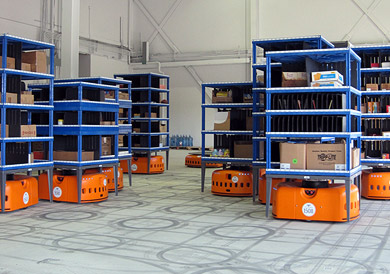April 7, 2012
 Kiva Systems Robots
Kiva Systems Robots
It has been fascinating to see the recent buzz around Kiva Systems robots controlling and working the floor spaces of warehouses.
According to some current reports, the Kiva Systems alone is now being used in up to two dozen larger corporation warehouses, including Amazon and Staples.
So impressed, Amazon acquired the 9 year old Kiva Systems company for $775 Million. It is sure to have a positive, efficiency impact on Amazon, a company that spends $4.6 Billion on warehouse operations. Considered to be expensive capital costs to start, but in the long-term, will save companies money with efficiencies created. Check out this informative YouTube video of Kiva Systems at work.
 Automation Impacts
Automation Impacts
If this initiates the reoccurring trend and debate around automation, what does this mean in a country that is dying for an absolute job turnaround? The criticism of automation using machines, robots, and electronics is that those methods directly impact labor jobs, resulting in job loss, people loss.
However, in start-up operations with automation implemented right away there will be no pain of job loss or reduction. In some cases, businesses may establish a new arm or warehouse in an expansion project to run a pilot project of automation.
Kiva Systems Automation Success
Recently acquired by Amazon, the Kiva Systems Company is doing well, with reports of triple figure growth and profitable figures. More corporations are jumping on board seeing the value and reliability of modern automation. Initial kinks have been straightened out and it has been reported that Kiva systems are operating in a flawless manner.
It is interesting to watch videos, demonstrating the efficiency and power of these little orange Kiva robots moving about the warehouse, sliding under a customized skid, lifting and following a programmed route on the floor full of sensors. You could imagine the programming behind such as a system is complicated, but obviously achievable from an operational perspective. Within the programming there must be many logic functions to almost allow these robots to alter or find best routes from A to B when traffic gets congested, as seen in some of these videos.
Human Labour
Human power is still evident in these automated warehouses, at stations loading and unloading these skid towers and scanning products before the Kiva robot takes off again. Obviously there are probably backup plans of a labour force filling in for Kiva robots when the system is “down”. How often have we all experienced system or computer failures? There will always be a requirement for a well-trained labor force behind maintaining these robots, building them and developing coding and programming.
Cost Benefit Analysis
On the simple cost-benefit analysis side of things, if the capital and operating costs of automated, innovative processes and assets are less than the cost of non-automated, labour process over a defined period of time, then your organization could experience greater profitability and decreased issues around human resources.
Millions of dollars must be spent acquiring a system such as the Kiva system. These corporations would undertake their own due diligence, such as a cost-benefit analysis on an automated system vs. conventional warehouse system full of employees driving skid steerer and forklift machines. Based on many assumptions, savings could be realized even with a Kiva Systems basic scenario implemented.
Kiva Systems Possible Limitations
Evident in the demonstration videos is the fact that warehouse space (height) is not being used to full capacity with Kiva Systems in place. In the conventional warehouse system, pallets of products are stacked 30-40 feet high in warehouse shelving frames. There appears to be limitations in volume with the Kiva robots lifting and moving the customized pallets that are 6-8 feet in height, and in terms of dimensions of the pallet, a 3 by 3 footprint. With a system like this, warehouse space and volume can be planned effectively with respect to capabilities of this system.
As previously mentioned, automated, computerized systems sometimes experience glitches. Power outages, coding and programming flaws, electronic interference, physical obstructions, logic flaws and an underestimation of operational issues come to mind when brainstorming the potential issues that could arise. However, the corporation is probably well prepared with fixes and contingencies for everything. Build into the program, the system does appear to monitor power levels and automatically schedules charging.
Kiva Systems Opportunities
If the Kiva Systems automated world continues to build, opportunities in other areas could emerge, such as a team of robots to:
- Carry out office work
- Automate the front counter at a fast food restaurant
- Sort and file books at libraries
- Fully automate beauty salon duties, with programmed robots completing hair and body packages
If these examples above come to fruition, this would now look like a scene of the Disney movie WALL-E. For sure WALL-E would feel comfortable and at home within a Kiva Systems environment. It has been interesting to read and see the new buzz around this system. What will be more interesting in the future to observe will be the impacts and the adjustments made to the human labor force, in the development of more value-added jobs around systems like the Kiva Systems model.
Business information, resources and tips for the entrepreneur
© 2012 Strategy Plan One
No comments:
Post a Comment